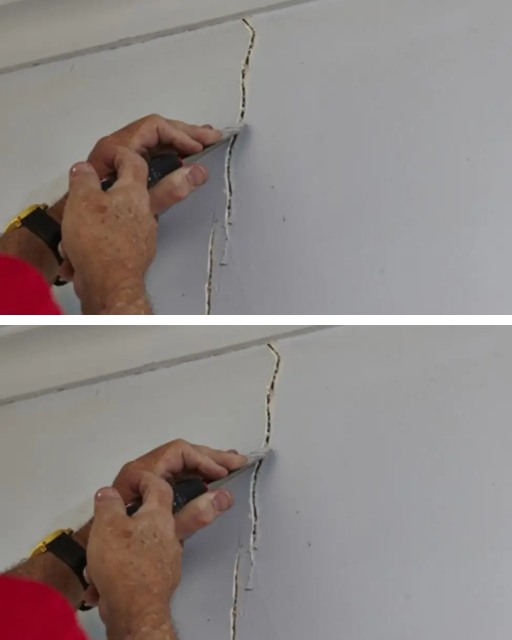ADVERTISEMENT
to clean out dirt, dust, and any loose debris from the crack to ensure the filler will bond effectively.
For Complete Cooking STEPS Please Head On Over To Next Page Or Open button (>) and don’t forget to SHARE with your Facebook friends
4. Fill the Crack with the Appropriate Compound
Now that the area is prepared, it’s time to fill the crack. The type of filler you use will depend on the material you’re repairing.
For Drywall and Plaster Cracks:
- Apply the compound: Use a putty knife to apply a thin layer of joint compound or plaster patching compound over the crack. For larger cracks, you may want to apply a layer of joint tape first, to reinforce the crack and prevent future issues.
- Press into the crack: Smooth the compound into the crack and spread it evenly to fill the entire area.
- Remove excess: After applying the compound, wipe away excess with the edge of your putty knife. The goal is to fill the crack, but leave the surface as smooth as possible.
For Concrete Cracks:
- Apply concrete filler: Using a trowel or putty knife, apply concrete filler or epoxy directly into the crack. Press down firmly to ensure the filler goes deep into the crack.
- Level the surface: Use the trowel to smooth the surface, ensuring it is level with the rest of the concrete.
- Let it dry: Follow the manufacturer’s instructions on drying time for the concrete filler. Most products will require at least a few hours to dry completely, and some may need a second application.
5. Smooth and Sand the Area
Once the filler has dried, you’ll need to smooth the area to make it flush with the surrounding surface. This ensures a seamless repair that blends with the rest of the wall or floor.
- For drywall and plaster: Use fine-grit sandpaper to gently sand the patched area. Sand in a circular motion to ensure the patch is smooth and level with the wall. If necessary, apply a second coat of joint compound, allow it to dry, and sand again until smooth.
- For concrete: Once the filler has dried, you can lightly sand the surface to make it even with the surrounding concrete. Use medium-grit sandpaper or a concrete sanding block.
6. Prime and Paint (or Seal)
After smoothing the patched area, you’ll want to prime and paint the surface to ensure the repair blends well with the rest of the wall or floor.
- For drywall and plaster:
- Prime the patched area: Apply a coat of primer over the patched area to seal the compound and help the paint adhere properly.
- Paint: Once the primer has dried, apply the paint color that matches your walls. If necessary, apply a second coat of paint for a uniform finish.
- For concrete:
- Seal the patch: If you’re repairing concrete, it’s a good idea to apply a concrete sealer to the patched area to protect it from moisture and dirt. This will also help the area blend in with the rest of the surface.
- For Complete Cooking STEPS Please Head On Over To Next Page Or Open button (>) and don’t forget to SHARE with your Facebook friends
7. Monitor and Maintain the Area
After completing the repair, it’s important to monitor the area for any signs of cracking or damage. If the crack reappears, it could indicate an underlying issue, such as foundation settlement or water damage.
For drywall or plaster cracks, it’s a good idea to inspect the repaired area every few months, especially in high-moisture areas like bathrooms. For concrete cracks, ensure that the repair remains sealed and that there are no further signs of deterioration.
Tips for Repairing Larger Cracks or Fissures
- For large cracks in drywall: If the crack is too wide to simply fill with compound, you may need to use joint tape or mesh to reinforce the repair. Apply the tape over the crack before applying compound.
- For foundation cracks: If you notice large, deep cracks in your foundation or floors, it’s best to consult with a professional. Structural issues could be the cause of these cracks, and they may require more extensive repair methods, such as foundation underpinning.
Final Thoughts
Repairing cracks and fissures in your home doesn’t have to be a difficult or expensive task. With the right materials and a bit of patience, you can restore the integrity of your walls, ceilings, and floors. Whether you’re repairing drywall, plaster, or concrete, following this step-by-step guide will help you achieve smooth, professional-looking results. Remember, if the cracks are due to serious underlying issues, don’t hesitate to consult with a professional to ensure your home remains safe and stable.
